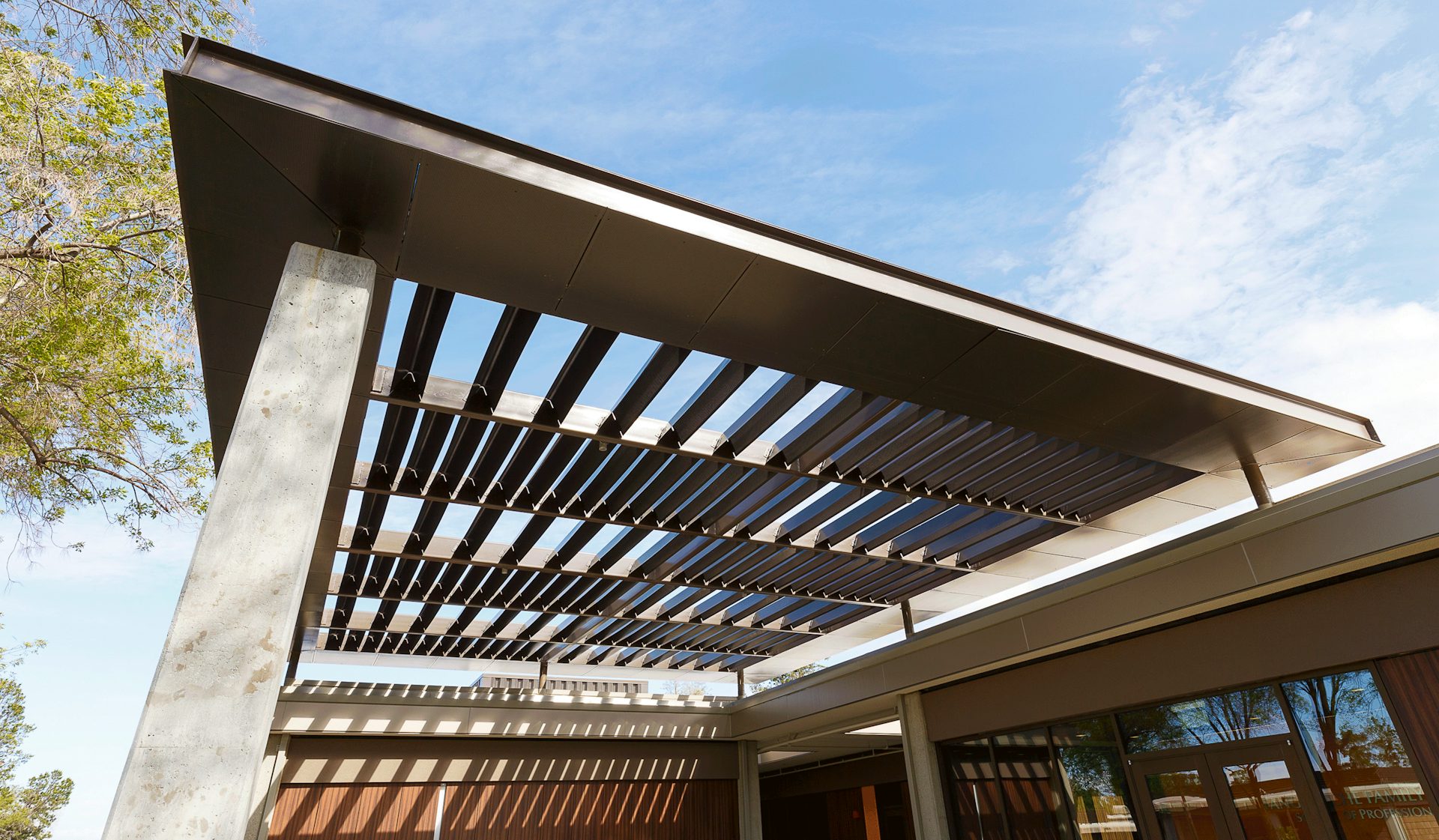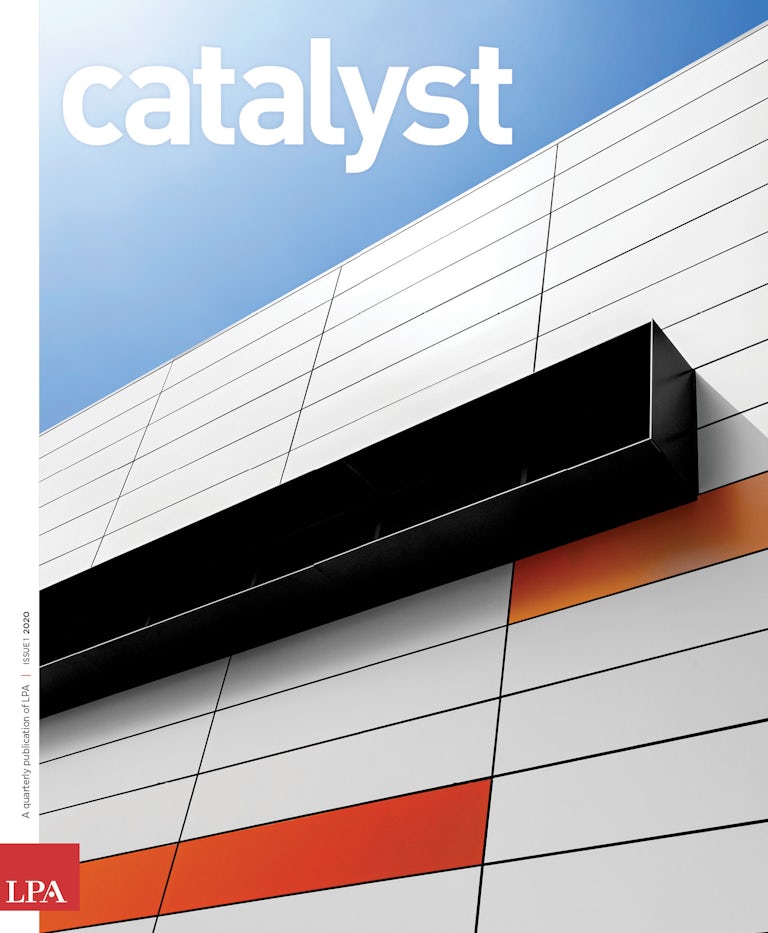West Valley College’s School of Professional Studies was a dark and uninviting block of a building, an icon of school design of the 1970s, when the college started exploring options for its future a few years ago. The school was getting a new benefactor and a new name; a makeover of the building was badly needed to support the re-branding of the professional studies school and its growing entrepreneurship curriculum.
The new Che School of Professional Studies is part of a 143-acre campus in the foothills of the Santa Cruz Mountains, on the southwest border of Silicon Valley. There is a rural feel to the school, with mature trees and an arroyo running through the heart of the campus, which is being upgraded to meet the demands of the energized regional business community. LPA had already worked on several projects for West Valley College, including the renovation of the Cilker School of Art and Design, which is located next to the School of Professional Studies.
A Case Study in Renovation
The makeover of the West Valley College School of Professional Studies saved the structure, developed open learning environments and created a facility that reduces fossil fuel use by 90 percent.


The future of the aging professional studies building was developed through a shared governance process, engaging a diverse group of stakeholders. The facility needed to support a wide range of programs, including business administration, engineering, computer science and criminology, each with its own requirements and interests. The process revealed the need for flexible spaces that could support multi-modal learning, team teaching and distance learning. It also made it clear that a smart design approach could save the bones of the building.
“The process really worked to examine the needs of all the different stakeholders,” says Steve Flanagan, LPA Director of Higher Education. “When everything was considered, it was clear that renovating the existing building was the most cost-effective approach.”
The renovation creates a welcoming presence for the center, with a clearly defined front entrance that didn’t exist in the original building. The design also opened the spaces to natural light while creating technology rich, flexible learning spaces that can be adapted to the shifting needs of the different programs.
“The design connects the building to photovoltaic panels installed on campus, which helped reduce the fossil fuel energy use in the building by 90%, surpassing the AIA 2030 Commitment target.”


The original building was torn down to the structure, except for limited areas clad in exterior shingles, and the interiors were reorganized to create a new grand entrance visible from the front of campus. A bright, open reception area greets visitors and covered walkways connect the different classrooms. “A big part of what we were trying to do was to create an identifiable and welcoming front door,” says LPA Design Director Helen Pierce.
The solid walls in many parts of the building were replaced with floor-to-ceiling glass. The Entrepreneurship Center connects to two classrooms and features a garage door that can be opened to an outdoor patio. All the classes are visible from the walkways. “We put education and the activities within the building on display,” Flanagan says.
The dark, blocky building is now filled with light and views of the campus. Strategically placed skylights add natural light in larger spaces. “Our main objective was to place education on display with transparent glass walls that provide daylight and visual access into the rooms,” Pierce says.
The building’s “good bones” were preserved and played key roles in the design. The existing concrete pillars were exposed to express the building’s structure and provide the framework and support for new walls of glass. The concrete pillars received seismic upgrades to bring the structure up to modern standards. In order to maintain the building and campus’ original character, the original tile façade—a style which can be found throughout the campus--was restored in select locations to its original condition.

The interiors were completely redone and reorganized. Administrative offices were moved to the front of the facility, where they take advantage of new walls of glass and operable windows. Classrooms were redesigned and upgraded with state-of-the-art technology, including computer labs. An accessible tiered classroom serves multiple uses for lectures and presentations. The Entrepreneurship Center is a flexible room that can adjust to the needs of the program.
Sustainability was an important part of the College’s agenda from the start of the process, including the decision to preserve and reuse the existing concrete, steel and wood structure.

The original mandate targeted LEED Silver certification, but the project ultimately earned LEED Gold. The design, which included a seismic upgrade, incorporates a sustainable approach to every aspect of the remodel including strategic building reuse and increased daylighting, new high-efficiency zoned HVAC systems, LED lighting and low water use and native landscape strategies. The design connects the building to photovoltaic panels installed on campus, which helped reduce the fossil fuel energy use in the building by 90 percent, surpassing the AIA 2030 Commitment target.
The final building exceeded the college’s original goals, efficiently saved the existing structure and created a new welcoming and efficient facility for the growing campus, with the college President now refers to as his favorite building on campus.
















